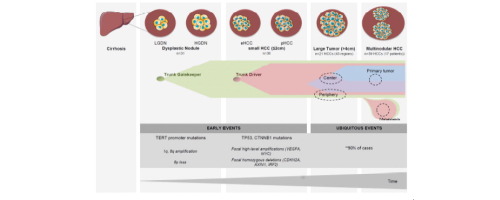当前位置:
X-MOL 学术
›
J. Hepatol.
›
论文详情
Our official English website, www.x-mol.net, welcomes your feedback! (Note: you will need to create a separate account there.)
Trunk events present minimal intra- and inter-tumoral heterogeneity in hepatocellular carcinoma
Journal of Hepatology ( IF 25.7 ) Pub Date : 2017-12-01 , DOI: 10.1016/j.jhep.2017.08.013 Sara Torrecilla , Daniela Sia , Andrew N. Harrington , Zhongyang Zhang , Laia Cabellos , Helena Cornella , Agrin Moeini , Genis Camprecios , Wei-Qiang Leow , Maria Isabel Fiel , Ke Hao , Laia Bassaganyas , Milind Mahajan , Swan N. Thung , Augusto Villanueva , Sander Florman , Myron E. Schwartz , Josep M. Llovet
Journal of Hepatology ( IF 25.7 ) Pub Date : 2017-12-01 , DOI: 10.1016/j.jhep.2017.08.013 Sara Torrecilla , Daniela Sia , Andrew N. Harrington , Zhongyang Zhang , Laia Cabellos , Helena Cornella , Agrin Moeini , Genis Camprecios , Wei-Qiang Leow , Maria Isabel Fiel , Ke Hao , Laia Bassaganyas , Milind Mahajan , Swan N. Thung , Augusto Villanueva , Sander Florman , Myron E. Schwartz , Josep M. Llovet

|
BACKGROUND & AIMS
According to the clonal model of tumor evolution, trunk alterations arise at early stages and are ubiquitous. Through the characterization of early stages of hepatocarcinogenesis, we aimed to identify trunk alterations in hepatocellular carcinoma (HCC) and study their intra- and inter-tumor distribution in advanced lesions. METHODS
A total of 151 samples representing the multistep process of hepatocarcinogenesis were analyzed by targeted-sequencing and a single nucleotide polymorphism array. Genes altered in early lesions (31 dysplastic nodules [DNs] and 38 small HCCs [sHCC]) were defined as trunk. Their distribution was explored in: a) different regions of large tumors (43 regions, 21 tumors), and b) different nodules of the same patient (39 tumors, 17 patients). Multinodular lesions were classified as intrahepatic metastases (IMs) or synchronous tumors based on chromosomal aberrations. RESULTS
TERT promoter mutations (10.5%) and broad copy-number aberrations in chromosomes 1 and 8 (3-7%) were identified as trunk gatekeepers in DNs and were maintained in sHCCs. Trunk drivers identified in sHCCs included TP53 (23%) and CTNNB1 (11%) mutations, and focal amplifications or deletions in known drivers (6%). Overall, TERT, TP53 and CTNNB1 mutations were the most frequent trunk events and at least one was present in 51% of sHCCs. Around 90% of mutations in these genes were ubiquitous among different regions of large tumors. In multinodular HCCs, 35% of patients harbored IMs; 85% of mutations in TERT, TP53 and/or CTNNB1 were retained in primary and metastatic tumors. CONCLUSIONS
Trunk events in early stages (TERT, TP53, CTNNB1 mutations) were ubiquitous across different regions of the same tumor and between primary and metastatic nodules in >85% of cases. This concept supports the knowledge that single biopsies would suffice to capture trunk mutations in HCC. LAY SUMMARY
Trunk alterations arise at early stages of cancer and are shared among all malignant cells of the tumor. In order to identify trunk alterations in HCC, we characterized early stages of hepatocarcinogenesis represented by dysplastic nodules and small lesions. Mutations in TERT, TP53 and CTNNB1 genes were the most frequent. Analyses in more advanced lesions showed that mutations in these same genes were shared between different regions of the same tumor and between primary and metastatic tumors, suggesting their trunk role in this disease.
更新日期:2017-12-01



























 京公网安备 11010802027423号
京公网安备 11010802027423号